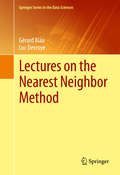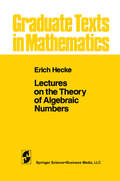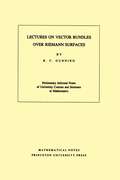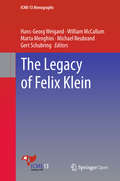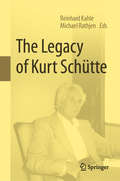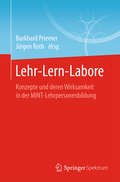- Table View
- List View
Lectures on the Nearest Neighbor Method (Springer Series in the Data Sciences)
by Gérard Biau Luc DevroyeThis text presents a wide-ranging and rigorous overview of nearest neighbor methods, one of the most important paradigms in machine learning. Now in one self-contained volume, this book systematically covers key statistical, probabilistic, combinatorial and geometric ideas for understanding, analyzing and developing nearest neighbor methods. Gérard Biau is a professor at Université Pierre et Marie Curie (Paris). Luc Devroye is a professor at the School of Computer Science at McGill University (Montreal).
Lectures on the Random Field Ising Model: From Parisi-Sourlas Supersymmetry to Dimensional Reduction (SpringerBriefs in Physics)
by Slava RychkovThis book is about the Random Field Ising Model (RFIM) – a paradigmatic spin model featuring a frozen disordering field. The focus is on the second-order phase transition between the paramagnetic and ferromagnetic phases, and the associated critical exponents. The book starts by summarizing the current knowledge about the RFIM from experiments, numerical simulations and rigorous mathematical results. It then reviews the classic theoretical works from the 1970’s which suggested a property of dimensional reduction – that the RFIM critical exponents should be the same as for the ordinary, non-disordered, Ising model of lower dimensionality, and related this an emergent Parisi-Sourlas supersymmetry. As is now known, these remarkable properties only hold when the spatial dimensionality of the model is larger than a critical dimension. The book presents a method to estimate the critical dimension, using standard tools such as the replica trick and perturbative renormalization group, whose result is in agreement with the numerical simulations. Some more elementary steps in the derivations are left as exercises for the readers. This book is of interest to researchers, PhD students and advanced master students specializing in statistical field theory.
Lectures on the structure of algebraic groups and geometric applications
by Michel Brion Preena SamuelLectures on the Theory of Algebraic Functions of One Variable (Lecture Notes in Mathematics #314)
by Max DeuringLectures on the Theory of Algebraic Numbers (Graduate Texts in Mathematics #77)
by E. T. Hecke. . . if one wants to make progress in mathematics one should study the masters not the pupils. N. H. Abel Heeke was certainly one of the masters, and in fact, the study of Heeke L series and Heeke operators has permanently embedded his name in the fabric of number theory. It is a rare occurrence when a master writes a basic book, and Heeke's Lectures on the Theory of Algebraic Numbers has become a classic. To quote another master, Andre Weil: "To improve upon Heeke, in a treatment along classical lines of the theory of algebraic numbers, would be a futile and impossible task. " We have tried to remain as close as possible to the original text in pre serving Heeke's rich, informal style of exposition. In a very few instances we have substituted modern terminology for Heeke's, e. g. , "torsion free group" for "pure group. " One problem for a student is the lack of exercises in the book. However, given the large number of texts available in algebraic number theory, this is not a serious drawback. In particular we recommend Number Fields by D. A. Marcus (Springer-Verlag) as a particularly rich source. We would like to thank James M. Vaughn Jr. and the Vaughn Foundation Fund for their encouragement and generous support of Jay R. Goldman without which this translation would never have appeared. Minneapolis George U. Brauer July 1981 Jay R.
Lectures on the Theory of Games (AM-37)
by Harold William KuhnThis book is a spectacular introduction to the modern mathematical discipline known as the Theory of Games. Harold Kuhn first presented these lectures at Princeton University in 1952. They succinctly convey the essence of the theory, in part through the prism of the most exciting developments at its frontiers half a century ago. Kuhn devotes considerable space to topics that, while not strictly the subject matter of game theory, are firmly bound to it. These are taken mainly from the geometry of convex sets and the theory of probability distributions. The book opens by addressing "matrix games," a name first introduced in these lectures as an abbreviation for two-person, zero-sum games in normal form with a finite number of pure strategies. It continues with a treatment of games in extensive form, using a model introduced by the author in 1950 that quickly supplanted von Neumann and Morgenstern's cumbersome approach. A final section deals with games that have an infinite number of pure strategies for the two players. Throughout, the theory is generously illustrated with examples, and exercises test the reader's understanding. A historical note caps off each chapter. For readers familiar with the calculus and with elementary matrix theory or vector analysis, this book offers an indispensable store of vital insights on a subject whose importance has only grown with the years.
Lectures on Topological Fluid Mechanics: Lectures given at the C.I.M.E. Summer School held in Cetraro, Italy, July 2 - 10, 2001 (Lecture Notes in Mathematics #1973)
by Mitchell A. Berger Louis H. Kauffman Boris Khesin H. Keith Moffatt Renzo L. Ricca De Witt SumnersHelmholtz's seminal paper on vortex motion (1858) marks the beginning of what is now called topological fluid mechanics.After 150 years of work, the field has grown considerably. In the last several decades unexpected developments have given topological fluid mechanics new impetus, benefiting from the impressive progress in knot theory and geometric topology on the one hand, and in mathematical and computational fluid dynamics on the other. This volume contains a wide-ranging collection of up-to-date, valuable research papers written by some of the most eminent experts in the field. Topics range from fundamental aspects of mathematical fluid mechanics, including topological vortex dynamics and magnetohydrodynamics, integrability issues, Hamiltonian structures and singularity formation, to DNA tangles and knotted DNAs in sedimentation. A substantial introductory chapter on knots and links, covering elements of modern braid theory and knot polynomials, as well as more advanced topics in knot classification, provides an invaluable addition to this material.
Lectures on Variational Analysis (Applied Mathematical Sciences #205)
by Asen L. DontchevThis book presents an introduction to variational analysis, a field which unifies theories and techniques developed in calculus of variations, optimization, and control, and covers convex analysis, nonsmooth analysis, and set-valued analysis. It focuses on problems with constraints, the analysis of which involves set-valued mappings and functions that are not differentiable. Applications of variational analysis are interdisciplinary, ranging from financial planning to steering a flying object. The book is addressed to graduate students, researchers, and practitioners in mathematical sciences, engineering, economics, and finance. A typical reader of the book should be familiar with multivariable calculus and linear algebra. Some basic knowledge in optimization, control, and elementary functional analysis is desirable, but all necessary background material is included in the book.
Lectures on Vector Bundles over Riemann Surfaces. (Mathematical Notes #105)
by Robert C. GunningThe description for this book, Lectures on Vector Bundles over Riemann Surfaces. (MN-6), Volume 6, will be forthcoming.
Lectures on Vector Bundles over Riemann Surfaces. (MN-6), Volume 6
by Robert C. GunningThe description for this book, Lectures on Vector Bundles over Riemann Surfaces. (MN-6), Volume 6, will be forthcoming.
Lectures on Visco-Plastic Fluid Mechanics (CISM International Centre for Mechanical Sciences #583)
by Guillaume Ovarlez Sarah HormoziThe book is designed for advanced graduate students as well as postdoctoral researchers across several disciplines (e.g., mathematics, physics and engineering), as it provides them with tools and techniques that are essential in performing research on the flow problems of visco-plastic fluids. The following topics are treated: analysis of classical visco-plastic fluid modelsmathematical modeling of flows of visco-plastic fluidscomputing flows of visco-plastic fluidsrheology of visco-plastic fluids and visco-plastic suspensionsapplication of visco-plastic fluids in engineering sciencescomplex flows of visco-plastic fluids.
Lectures on Viscoelasticity Theory (Applied Mathematical Sciences #7)
by Allen C. PipkinThis book contains notes for a one-semester course on viscoelasticity given in the Division of Applied Mathematics at Brown University. The course serves as an introduction to viscoelasticity and as a workout in the use of various standard mathematical methods. The reader will soon find that he needs to do some work on the side to fill in details that are omitted from the text. These are notes, not a completely de tailed explanation. Furthermore, much of the content of the course is in the prob lems assigned for solution by the student. The reader who does not at least try to solve a good many of the problems is likely to miss most of the point. Much that is known about viscoelasticity is not discussed in these notes, and references to original sources are usually not given, so it will be difficult or impossible to use this book as a reference for looking things up. Readers wanting something more like a treatise should see Ferry's Viscoelastic Properties of Polymers, Lodge's Elastic Liquids, the volumes edited by Eirich on Rheology, or any issue of the Transactions of the Society of Rheology. These works emphasize physical aspects of the subject. On the mathematical side, Gurtin and Sternberg's long paper On the Linear Theory of Viscoelasticity (ARMA~, 291(1962)) remains the best reference for proofs of theorems.
Led by Donkeys: How four friends with a ladder took on Brexit
by LedByDonkeys Ben Stewart James Sadri Oliver KnowlesThe official account - complete with full-colour illustrations - of how four ordinary people managed to expose the government's hypocrisies through a nationwide guerrilla advertising campaign.Seeking to highlight the hypocrisy of our politicians on Brexit four friends armed with nothing more than ladders, roller brushes and a treasure trove of damning statements from our leaders slapped up the politicians' biggest lies on billboards around the country.This guerrilla operation wasn't easy, but it wasn't long before the British public enabled them to take things into their own hands - and the rest is history. Leave the EU or remain? An apparently simple question divided the nation in historic fashion. Many of us believed the words of these politicians. By putting up their quotes as billboards, self-styled 'Led By Donkeys' had clear intentions - to compare the promises that have been made across the years with the damning reality.
The Lefschetz Properties (Lecture Notes in Mathematics #2080)
by Tadahito Harima Toshiaki Maeno Hideaki Morita Yasuhide Numata Akihito Wachi Junzo WatanabeThis is a monograph which collects basic techniques, major results and interesting applications of Lefschetz properties of Artinian algebras. The origin of the Lefschetz properties of Artinian algebras is the Hard Lefschetz Theorem, which is a major result in algebraic geometry. However, for the last two decades, numerous applications of the Lefschetz properties to other areas of mathematics have been found, as a result of which the theory of the Lefschetz properties is now of great interest in its own right. It also has ties to other areas, including combinatorics, algebraic geometry, algebraic topology, commutative algebra and representation theory. The connections between the Lefschetz property and other areas of mathematics are not only diverse, but sometimes quite surprising, e.g. its ties to the Schur-Weyl duality. This is the first book solely devoted to the Lefschetz properties and is the first attempt to treat those properties systematically.
The Legacy of Alladi Ramakrishnan in the Mathematical Sciences
by Krishnaswami Alladi John R. Klauder Calyampudi R. RaoIn the spirit of Alladi Ramakrishnan’s profound interest and contributions to three fields of science — Mathematics, Statistics, and Physics — this volume contains invited surveys and research articles from prominent members of these communities who also knew Ramakrishnan personally and greatly respected his influence in these areas of science. Historical photos, telegrams, and biographical narratives of Alladi Ramakrishnan’s illustrious career of special interest are included as well.
The Legacy of Felix Klein (ICME-13 Monographs)
by Hans-Georg Weigand William McCallum Marta Menghini Michael Neubrand Gert SchubringThis open access book provides an overview of Felix Klein’s ideas, highlighting developments in university teaching and school mathematics related to Klein’s thoughts, stemming from the last century. It discusses the meaning, importance and the legacy of Klein’s ideas today and in the future, within an international, global context. Presenting extended versions of the talks at the Thematic Afternoon at ICME-13, the book shows that many of Klein’s ideas can be reinterpreted in the context of the current situation, and offers tips and advice for dealing with current problems in teacher education and teaching mathematics in secondary schools. It proves that old ideas are timeless, but that it takes competent, committed and assertive individuals to bring these ideas to life. Throughout his professional life, Felix Klein emphasised the importance of reflecting upon mathematics teaching and learning from both a mathematical and a psychological or educational point of view. He also strongly promoted the modernisation of mathematics in the classroom, and developed ideas on university lectures for student teachers, which he later consolidated at the beginning of the last century in the three books on elementary mathematics from a higher standpoint.
The Legacy of Hans Freudenthal
by Leen StreeflandThe Legacy of Freudenthal pays homage to Freudenthal and his work on mathematics, its history and education. Almost all authors were his scholars or co-workers. They testify to what they learned from him. Freudenthal himself contributes posthumously. His didactical phenomenology of the concept of force is both provocative and revealing in its originality, compared with what is usually found in physics instruction. Freudenthal is portrayed as a universal human being by Josette Adda. He made considerable contributions to mathematics itself, e.g. on homotopy theory and Lie groups in geometry. The exposition of Freudenthal's mathematical life and work is on Van Est's account. Henk Bos discusses his historical work. The essay review of the 8th edition of Hilbert's Grundlagen der Geometrie serves as a vehicle of thought. The main part of the book, however, concerns Freudenthal's work on mathematics education. Christine Keitel reviews his final book Revisiting Mathematics Education (1991). Fred Goffree describes Freudenthal's `Working on Mathematics Education' both from an historical as well as a theoretical perspective. Adrian Treffers analyses Freudenthal's influence on the development of realistic mathematics education at primary level in the Netherlands, especially his influence on the Wiskobas-project of the former IOWO. Freudenthal once predicted the disappearance of mathematics as an individual subject in education sometime around the year 2000, because it would by then have merged with integrated thematic contexts. Jan de Lange anticipates this future development and shows that Freudenthal's prediction will not come true after all. Reflective interludes unveil how he might have influenced those developments. Freudenthal contributed a wealth of ideas and conceptual tools to the development of mathematics education -- on contexts, didactical phenomenology, guided reinvention, mathematisation, the constitution of mental objects, the development of reflective thinking, levels in learning processes, the development of a mathematical attitude and so on -- but he did not design very much concrete material. Leen Streefland deals with the question of design from a theoretical point of view, while applying Freudenthal's ideas on changing perspective and shifting. For teachers, researchers, mathematics educators, mathematicians, educationalists, psychologists and policy makers.
The Legacy of Kurt Schütte
This book on proof theory centers around the legacy of Kurt Schütte and its current impact on the subject. Schütte was the last doctoral student of David Hilbert who was the first to see that proofs can be viewed as structured mathematical objects amenable to investigation by mathematical methods (metamathematics). Schütte inaugurated the important paradigm shift from finite proofs to infinite proofs and developed the mathematical tools for their analysis. Infinitary proof theory flourished in his hands in the 1960s, culminating in the famous bound Γ0 for the limit of predicative mathematics (a fame shared with Feferman). Later his interests shifted to developing infinite proof calculi for impredicative theories. Schütte had a keen interest in advancing ordinal analysis to ever stronger theories and was still working on some of the strongest systems in his eighties. The articles in this volume from leading experts close to his research, show the enduring influence of his work in modern proof theory. They range from eye witness accounts of his scientific life to developments at the current research frontier, including papers by Schütte himself that have never been published before.
The Legacy of Mario Pieri in Foundations and Philosophy of Mathematics
by James T. Smith Elena Anne Marchisotto Francisco Rodríguez-ConsuegraMario Pieri on the Foundations of Philosophy and Mathematics introduces readers to Pieri’s career and his studies in foundations, from both historical and modern viewpoints, placing his life and research in context and tracing his influence on his contemporaries as well as more recent mathematicians. The text also includes translations and commentary on Pieri’s original analyses on projective geometry, transformational geometry.
The Legacy of Mario Pieri in Geometry and Arithmetic
by Elena Anne Marchisotto James T. SmithThis book is the first in a series of three volumes that comprehensively examine Mario Pieri’s life, mathematical work and influence. The book introduces readers to Pieri’s career and his studies in foundations, from both historical and modern viewpoints. Included in this volume are the first English translations, along with analyses, of two of his most important axiomatizations — one in arithmetic and one in geometry. The book combines an engaging exposition, little-known historical notes, exhaustive references and an excellent index. And yet the book requires no specialized experience in mathematical logic or the foundations of geometry.
The Legacy of Niels Henrik Abel: The Abel Bicentennial, Oslo, 2002
by Olav Arnfinn Laudal Ragni PieneA unique series of fascinating research papers on subjects related to the work of Niels Henrik Abel, written by some of the foremost specialists in their fields. Some of the authors have been specifically invited to present papers, discussing the influence of Abel in a mathematical-historical context. Others have submitted papers presented at the Abel Bicentennial Conference, Oslo June 3-8, 2002. The idea behind the book has been to produce a text covering a substantial part of the legacy of Abel, as perceived at the beginning of the 21st century.
The Legacy of Tatjana Afanassjewa: Philosophical Insights from the Work of an Original Physicist and Mathematician (Women in the History of Philosophy and Sciences #7)
by Jos Uffink Giovanni Valente Charlotte Werndl Lena ZuchowskiThis book presents a collection of essays that explore the life and works of Tatjana Afanassjewa (1876–1964), a Russian–Dutch physicist–mathematician. Readers will discover a scientist whose work on the foundations of thermodynamics significantly influenced the field itself as well as the philosophy of physics. This book highlights the philosophical consequences of her work in physics and mathematics and discusses historical aspects of her writings on the foundations of physics. In addition, it features English translations and critical reviews of key selections from her texts.First and foremost, the book highlights the numerous contributions that Afanassjewa made to the field. In particular, the authors examine her work on the foundations of thermodynamics and statistical physics, starting in the 1920s and extending to 1956, well after the untimely death of her husband in 1933. They also explore her almost entirely forgotten work on the didactics of mathematics. In addition, they discuss her influential collaboration with her husband, the Austrian physicist Paul Ehrenfest (1880–1933).The portrait that emerges is that of a highly original physicist and mathematician, whose legacy continues to influence scientists and philosophers today and whose lesser-known works deserve more attention than they have received. Readers will find a rich body of work that continues to this day to yield insights into the foundations of physics and mathematics.
Lehr-Lern-Labore: Konzepte und deren Wirksamkeit in der MINT-Lehrpersonenbildung
by Burkhard Priemer Jürgen RothAn verschiedenen Hochschulen werden in den MINT-Fächern Schülerlabore in die Lehrpersonenbildung integriert. In diesen - als Lehr-Lern-Labore bezeichneten - Einrichtungen werden MINT-Lernumgebungen für Schülerinnen und Schüler, Veranstaltungen der Lehrpersonenbildung und an vielen Standorten auch fachdidaktische Forschung fruchtbar miteinander verknüpft. Das Ziel ist dabei, evidenzbasiert innovative Lehrkonzepte für Schule und Hochschule zu entwickeln und zu implementieren. In diesem Band werden Lehr-Lern-Labore zunächst allgemein beschrieben und dann durch zahlreiche Beispiele von Konzepten verschiedener Hochschulstandorte illustriert. Darüber hinaus wird berichtet, welche Wirksamkeit Lehr-Lern-Labore bei der Förderung von Kompetenzen zukünftiger Lehrpersonen haben und wie Studierende diese Einrichtungen wahrnehmen. Die vorgestellten Forschungsergebnisse, die aus einem Verbund von sechs Hochschulen stammen, sollen durch diesen Band weiteren Standorten zugänglich gemacht werden. Dieses Buch richtet sich an Studierende und Dozierende der Lehrpersonenbildung in Hochschulen - insbesondere in den MINT-Fachdidaktiken - sowie an Personen in Schule und Referendariat.
